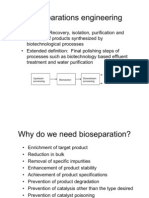Learning for Social Impact
Presentation for the Social Impact Exchange Conference on Scaling June 17, 2010
�Begin to design assessments by clarifying an initiatives objectives
Knowledge development Service/ product development and delivery Capacity enhancement and skills development Behavior change programs Enabling Policy systems and development infrastructure and development implementation
Frame the problem
6 types of social interventions
Develop approach 4 stages of the solution Demonstrate and refine the solution
Each intervention addresses social needs in a unique way and implies unique objectives for that initiative Even within a given intervention, initiative objectives differ at each stage of the solution Combining these two dimensions provides a set of initiative objectives that reflects the universe of social impact work
McKinsey & Company
Scale and sustain
| 1
�The 6 types of interventions describe the range of activities that address social needs
Knowledge development Service/ product development and delivery Capacity enhancement and skills development Behavior change programs Enabling Policy systems and development infrastructure and development implementation
Description Discovering, developing, interpreting or sharing knowledge to solve existing or expected problems
Providing goods and services to fulfill unmet needs of constituents
Helping organizations or individuals strengthen their capabilities
Sharing information and providing motivation to assist individuals to change their behavior for positive social benefits Seatbelt campaigns Drunkdriving awareness Handwashing
Establishing systems and infrastructure that facilitate social change
Promoting or resisting a change in government, multi-lateral, or corporate policy
Examples
Medical research Policy research Traditional wisdom
Soup kitchens Performing arts Anti-malaria bed nets Hybrid seeds
Vocational training Technical assistance
Networking Convenings Definition of common standards IT systems
Grassroots campaigns Lobbying Litigation
McKinsey & Company
| 2
�The 4 stages of the solution describe progress in addressing social needs
Description Frame the problem Define and fully understand the problem Examples Conduct analysis to understand key drivers of childhood obesity in the United States
Develop approach
Brainstorm ideas and design solution approach
Design alternative models for vocational training programs including implementation plan, costs, benefits and drawbacks Launch a new after-school program and refine its operations Assess a bed-net distribution program that has been operating for 5 years With federal government support, develop Childrens Zones in top 20 US cities based on the Harlem model
McKinsey & Company
Demonstrate and refine the solution
Implement approach at limited scale to test and refine the solution
Scale and sustain
Bring to scale and embed social impact in the status quo
| 3
�We defined the universe of initiative objectives
Knowledge development Service / product development and delivery Target constituents need and demand for service/product fully understood Proof of concept for service/product demonstrated Target constituents needs for service/product met in pilots Need and demand for all target constituents fully met by service/product Capacity enhancement and skills development Target constituents skills gap and demand for program fully understood Program options designed and most promising model selected New knowledge/ skills applied by constituents in pilots Capabilities/ skills gap for all target constituents fully met by program Behavior change programs Enabling systems and infrastructure development System gaps in coordination, trust and access fully understood Gap-closing options designed; most promising solution chosen Effective solution applied by early adopters System gaps eliminated through mainstream use of effective solution Policy development and implementation Context of issue and potential role for policy fully understood Policy options designed and most promising solution selected New policy position adopted by vanguard leaders Improvements due to full implementation and broad enforcement of new policy | 4
Frame the problem
Problems context, root causes, effects and scale are fully understood Evidence-based hypotheses and research method designed Hypothesis proven
Problems context, causes, effects and target constituents fully understood Program options designed, and most promising model selected New behavior exhibited by target constituents in pilots Problem solved through mainstream role modeling of new behavior by constituents
Develop approach
Demonstrate and refine the solution
Scale and sustain
New knowledge adopted and broadly applied to address problem
McKinsey & Company


























































